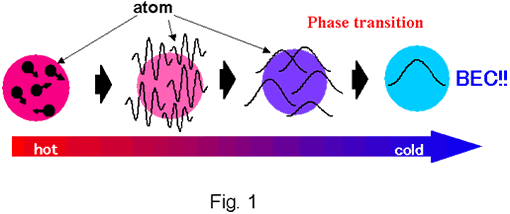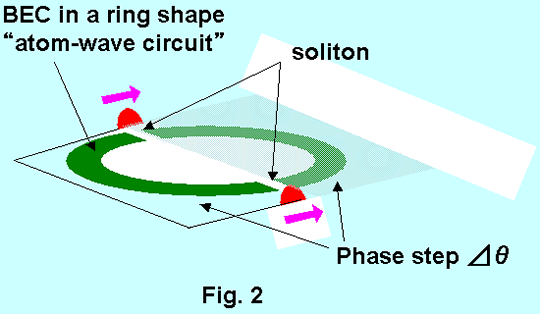|
 
 |
|
| Curriculum Vitae |
| |
Mitsutaka Kumakura received the B.Sc. degree from Kyoto University in 1987, and the D.Sc. degree from the Graduate University for Advanced Studies in 2000.
He was with Institute for Molecular Science (1988−2000) and Graduate School of Science, Kyoto University (2000−2006). In these laboratories he mainly engaged in experimental studies on the laser cooling of neutral atoms and the laser spectroscopy of exotic atoms and molecules.
Currently he is an Associate Professor at Graduate School of Engineering, University of Fukui.
His present research interest is novel quantum phenomena in quantum degenerate atomic gases. |
|
| Introduction of the project |
In 1995, the Bose-Einstein condensation in a dilute atomic vapor was realized by using laser cooling techniques. In this novel phase of matter, the atomic vapor behaves collectively as single coherent wave of matter, namely “matter-wave” (Fig.1). Its macroscopic wave character is attracting attention in various research fields, and novel technologies based on this feature, such as atom lasers and atom interferometers, are actively studied at present.
The aim of this project is to explore another feature of the matter-wave, namely, “nonlinearity”, which results from the interatomic interaction, and to develop novel applications based on the nonlinearity. So far, several attractive quantum phenomena caused by the nonlinearity were reported; for example, the self-trapping phenomenon in the quantum tunneling effect and so on. Among them we focus especially on matter-wave solitons in the Bose-Einstein condensate (BEC). |

Fig. 1 Phase transition to BEC
|
| Because of the repulsive interatomic interaction, the soliton is formed stably in the BEC as a dark soliton, that is, single depletion in the atom number density distribution. From the viewpoint of the matter-wave, the soliton is characterized as a phase step in the matter-field, which can be controlled with laser light, so that we can create, control, and observe the soliton directly by optical means. Each soliton behaves as an independent particle, and, therefore, it can be treated as a “signal” with a long lifetime in the matter-field. So far, nevertheless, it is difficult to maintain the soliton in a BEC during a long term, because the shape and inhomogeneity of the trap potential confining a BEC degrade its stability. For overcoming such experimental difficulty, we will newly develop an “atom-wave circuit” (Fig.2), |
 Fig. 2 Sitons in an atom-wave circuit Fig. 2 Sitons in an atom-wave circuit |
which is a BEC in a ring shape, and realize a matter-field ideal for studying the propagation of the soliton. With the atom-wave circuit we will make clear its propagation- and collision- characteristics, and will demonstrate the optical and/or electromagnetic control of the propagation also (Fig. 3).
The soliton acts as an indicator of the phase step in the matter-field. So that, this system is expected to operate as a novel type of atom interferometer. Through these experimental studies we will explore possibilities of applications of the system to such novel quantum devices based on quantum nonlinear phenomena.
To carry out these research programs I transferred to Fukui and set up a new lab in 2006. So far laser systems and UHV equipment have been constructed for laser cooling of Rb atoms, and experimental work on the creation of the BEC is now underway.

Fig. 3 Optical control of the soliton propagation by the phase imprint
|
|
| ▲UP |
|
|
|

